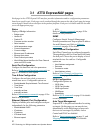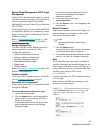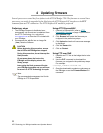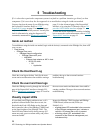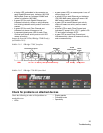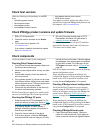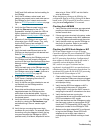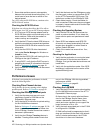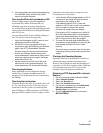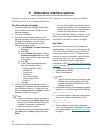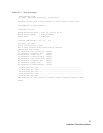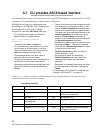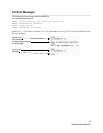
29
ATTO Technology Inc. iPBridge Installation and Operation Manual
7 Some older switches cannot autonegotiate
between the host and the switch properly. You
could have to force the host or switch to the
desired speed.
For a NIC using an OS iSCSI driver, continue to the
iSCSI OS driver section.
Checking the iSCSI OS driver
If the host uses a driver that allows the OS to talk to
iSCSI targets via a NIC, not an iSCSI storage adapter:
1 A PC using an iSCSI storage adapter and an
iSCSI OS driver might not work correctly on the
same machine. Check with the vendors to
make sure they are compatible.
2 Verify that the PC has the latest iSCSI driver as
well as the required service packs and patches.
Check with the iSCSI OS driver vendor for more
information.
3 Verify that the iSCSI OS driver has started.
Look under
Device Manager for Windows or
lsmod for Linux.
4 Verify that the iSCSI OS is still looking for the
iPBridge at the right IP address.
5 If using DHCP, verify that the DHCP server is
assigning the correct IP information to the host.
Refer to Getting an IP address
on page 10.
6 Verify that the NIC is configured with the correct
IP information.
7 Verify that the hosts and the iPBridge are using
the same port number to communicate iSCSI
on the ATTO ExpressNAV iSCSI page. The
default port number for the iPBridge is 3260.
8 Check cable integrity. Check the cables for
solid connections. Make sure they are plugged
in properly. Inspect cable ends for broken clips
and improper wiring.
Checking the Operating System
1 Verify that the OS has the required service
packs or patches installed. If not, obtain the
proper service packs and patches and install
them.
2 Some iSCSI host adapters and iSCSI OS
drivers do not always automatically find new
targets when plugged in or when forced to
rescan. Reboot the hosts.
3 Check if the vendor has a new driver. If so,
install it.
Checking the Applications
1 Verify that the application is running the latest
device drivers for the devices connected to
iPBridge. If not, get the latest device drivers and
install them.
2 Verify with the application vendor if the iSCSI
technology is supported on the version of the
application being used.
Performance Issues
If the host is not getting the performance it should,
check the following items.
Checking Fibre Channel devices
Verify that the devices are running at their highest
possible speed. Refer to
FCDataRate
on page 48.
Checking the iPBridge Ethernet ports
1 Verify that the data ports are set to auto
negotiate or forced to 1000 Mbs on the
ExpressNAV Ethernet page.
2 Verify that the MTU size is set to optimal setting
for the LAN/WAN environment.
Refer to Getting an IP address
on page 10. 9k
frame size is the current optimized frame size
for the iPBridge. Smaller frame sizes causes a
decrease in performance.
3 Verify that the iPBridge
TraceLog feature is
disabled. Tracelog tracks certain events that
occur in the iPBridge. With this log enabled,
performance suffers.
Refer to TraceLog
on page 46.
Checking the LAN/WAN
1 Verify that the MTU size is set to optimal setting
for the LAN/WAN environment on the ATTO
ExpressNAV Ethernet page.
9k frame size is the current optimized frame
size for the iPBridge. Smaller frame sizes
causes a decrease in performance. Many
switch and router vendors do not support the
larger frame size of 9k or 16k.
2 Verify that each associated port in the IP SAN
is configured for 1000Mbs.
IP SAN traffic should be segmented so that it
does not interfere with the main LAN network
traffic.For better performance, the IP SAN
should be on its own set of hardware.



